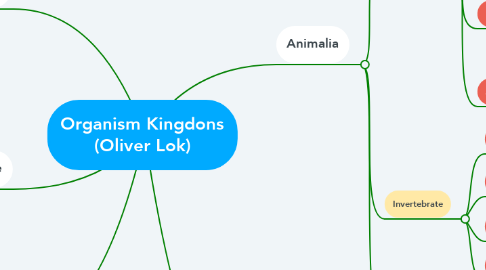
1. Protista
1.1. Amoebas
1.2. Algae
1.3. Euglena
1.4. Plasmodium
1.5. Slime Molds
2. Animalia
2.1. Vertabrate
2.1.1. Reptiles
2.1.1.1. Reptiles are tetrapod animals in the class Reptilia, comprising today's turtles, crocodilians, snakes, amphisbaenians, lizards, tuatara, and their extinct relatives.
2.1.1.1.1. Lizard
2.1.2. Mammals
2.1.2.1. Mammals are vertebrate animals constituting the class Mammalia, and characterized by the presence of mammary glands which in females produce milk for feeding their young, a neocortex, fur or hair
2.1.2.1.1. Monkey
2.1.3. Fish
2.1.3.1. Fish are animals that can be found in almost any form of water. They breathe through gills in order to extract oxygen out of the water
2.1.3.1.1. Goldfish
2.1.4. Birds
2.1.4.1. Birds are a group of warm-blooded vertebrates constituting the class Aves, characterized by feathers, toothless beaked jaws, the laying of hard-shelled eggs, a high metabolic rate, a four-chambered heart, and a strong yet lightweight skeleton.
2.1.4.1.1. Hummingbird
2.1.5. Amphibians
2.1.5.1. All can breathe and absorb water through their very thin skin. Amphibians also have special skin glands that produce useful proteins.
2.1.5.1.1. Amphibians are small vertebrates that need water, or a moist environment, to survive. The species in this group include frogs, toads, salamanders, and newts
2.2. Invertebrate
2.2.1. Insects
2.2.1.1. Three body sections and 6 legs
2.2.1.1.1. Fly
2.2.2. Arachnids
2.2.2.1. The bodies of arachnids are divided into two sections, the cephalothorax in front and the abdomen behind.
2.2.2.1.1. Spider
2.2.3. Crustanceans
2.2.3.1. Have a external bone structure (Crabs, shrimp, lobster etc)
2.2.3.1.1. Lobster
2.2.4. Myriapods
2.2.4.1. Have a long body with many sections and up to 750 legs
2.2.4.1.1. Centiped
